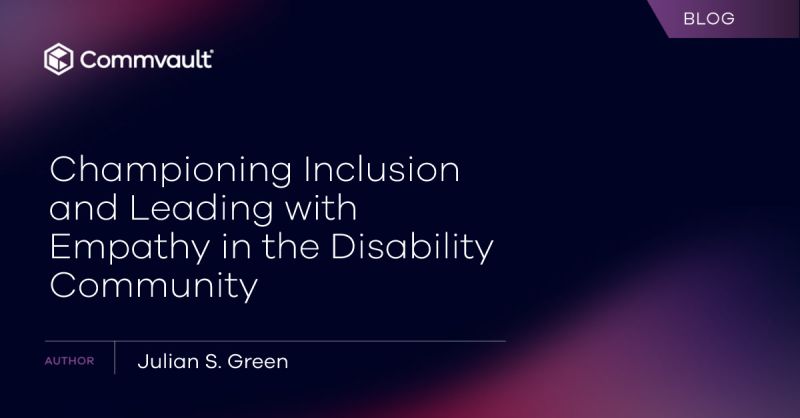Guiding Principles for Responsible Artificial Intelligence
For years, advancements in AI have revolutionized various aspects of daily lives and industries. AI has become an omnipresent force in how we communicate and in the services we use.
AI has emerged as a powerful tool for fortifying defenses in cyber resilience. It enables quicker response times, better-focused resources, reduced alert fatigue, and more time to focus on effective threat mitigation strategies.
However, alongside its undeniable potential, the rapid adoption and hype around Generative AI ignited a chorus of concerns surrounding privacy, transparency, and ethical considerations – and for good reason. The opacity of some AI algorithms, the potential for bias and discrimination, and the misuse of AI for malicious purposes have raised valid questions about the trustworthiness of this technology.
Companies at the forefront of AI must adopt careful and intentional strategies in its development. This is why Commvault has established principles that embody our dedication to ethical AI development and deployment.
AI at Commvault
AI is not new to Commvault. For over a decade, we have leveraged emergent artificial intelligence, machine learning, and intelligent automation to enhance our platform’s capabilities. This AI improves data protection and recovery operations, and assists customers in managing risk, locating sensitive data, and more.
Metallic AI is our intelligent control layer that powers Commvault Cloud. From automation and machine learning to advanced AI, Metallic AI brings greater performance and efficiency to every aspect of the Commvault Cloud platform.
Building Trustworthy AI
As we harness the power of AI in our products and services, we are committed to upholding ethical standards and ensuring responsible AI deployment. This is why we have incorporated the best practices outlined by NIST AI RMF 1.0. These measures help our AI deployment to be responsible, safe, and secure so that our customers can leverage the benefits of AI.
Valid and Reliable: Predictable and Accurate Results
We prioritize the reliability of our AI by implementing testing, quality assurance, and security measures.We strive to provide predictable and accurate AI responses and recommendations by using unbiased data for training and collecting feedback from human users. This feedback gathered through a simple like/dislike feature within our product and an option for more detailed user comments is crucial for the continual improvement of our AI and the accuracy of its outputs.
Safe: Human-Centric AI
A single decision can significantly impact the outcome of any scenario. Despite its power, AI often needs help grasping context as humans do because it misses the nuances involved in complex decision-making. Therefore, AI can only be trusted as one of the decision-makers, not a sole decision-maker. Humans should always maintain control, with oversight and accountability for actions taken based on AI-generated responses or recommendations.
Our AI is designed with safety mechanisms that allow for rapid response to unexpected behavior, always maintaining human control.
With this approach, we develop AI that enhances efficiencies and human potential and improves user experiences.
Secure and Resilient: Preventing Unauthorized Access
Our AI features are tightly integrated within the Commvault® Cloud platform, which restricts access to its functionalities from outside the platform. This means Commvault Cloud’s industry-leading security features are in place, including role-based access controls, which help prevent unauthorized access and keep systems secure and resilient.
We adhere to CIS Level 1 benchmarks to harden the infrastructure and minimize vulnerabilities. Additionally, we implement secure communications through encryption, loopback mode, and enforcement of client certification authentication.
Explainable and Interpretable: Understanding the What, How, and Why
AI should not be enigmatic black boxes. Instead, it should be transparent and understandable to all users and stakeholders. This means providing clear explanations for AI-generated responses and recommendations whenever appropriate.
We feed controlled data into the AI and maintain logs of the data sources from which responses and insights are derived. For certain Generative AI features, including Arlie™ Chatbot and API Code Assist, we provide users with references to the sources from which the answer has been extracted.
Privacy Enhanced: Protecting Customer Data
Privacy concerns surround AI risk conversations. AI relies on access to data to provide informed recommendations and predictions, making it crucial to comprehend the nuances of privacy and data security measures. Users should understand what data is utilized to train AI or might be shared with third parties.
At Commvault, safeguarding the privacy and security of personal data and sensitive information is paramount. We embed privacy and security by design principles into our Software Development Life Cycle and adhere to stringent data protection measures in alignment with industry data security standards throughout the AI life cycle.
Unlike other vendors, we make sure that customer data is never used to train our generative AI features, maintaining a strict barrier to safeguarding all customer information.
We use pre-trained LLM from OpenAI, inputting relevant data into them as context to extract responses and recommendations. For instance, Arlie utilizes pre-trained LLM along with context from Commvault product and API documentation, user query, error codes, error descriptions, and anonymized customer support resolutions. Human supervision oversees our generative AI output to confirm anonymization.
Fair: User Agnostic and Unbiased
Recognizing that AI can inadvertently perpetuate biases and discrimination, we take great care to design our AI to minimize biases and avoid discriminatory practices. We achieve this by training and testing our AI using diverse datasets that are agnostic to any specific user and do not contain protected characteristics such as race, age, or gender.
Accountable and Transparent: Driving User Confidence
Information about AI and its outputs should be accessible to those using it. This transparency and understanding fosters confidence among users in the AI.
We provide explicit AI entry points to make sure users are well-informed about AI intervention. We also establish a feedback loop, allowing users to provide input and contribute to the continuous improvement of our AI.
Offering Customer Choice to Opt in
Suppose your organization is still developing a strategy for Responsible AI and isn’t ready to implement Generative AI features. In that case, we provide the option to keep Arlie, the AI assistant for Commvault Cloud, inactive. For installed software, Arlie is not activated by default, offering customers the choice to activate or deactivate it anytime. In Commvault Cloud SaaS, while Arlie is enabled by default to improve the user experience, it does not perform any background data collection, maintaining customer data privacy. SaaS customers may opt out of using Arlie entirely if preferred.
Certain AI functionality, such as background-running machine learning used to flag anomalies, cannot be disabled. These AI features are local to each customer and do not interact with customer data.
Read Our Responsible AI Policy: commvault.com/legal/responsible-ai
Learn more about Metallic AI: commvault.com/platform/metallic-ai




